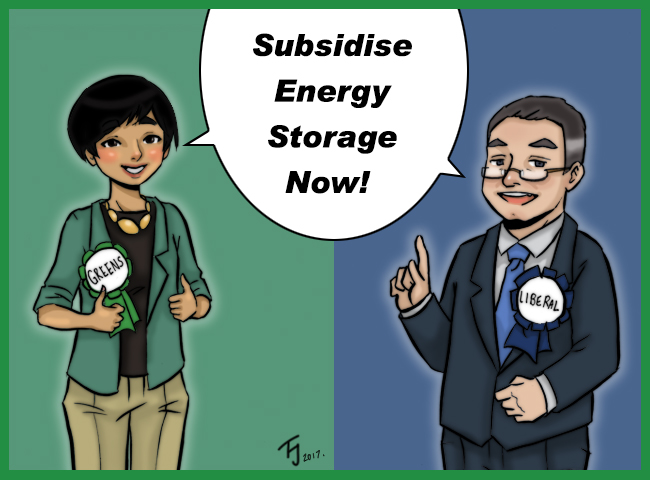
The Greens and the Libs agree on one thing at least: that storage should be subsidised. But should it?
The mainstream media has been full of news about energy storage over the last few months.
It started in July, with South Australia’s State Premier Jay Weatherill announcing Tesla would build the world’s largest lithium ion battery system.
Over in Canberra, the Coalition ridiculed the energy storage project. The federal Treasurer, Scott Morrison, likened it to,
and said,
“It is so at the margin it barely is worthy of a mention.”
Its construction is well underway now, but at $640 per kilowatt it isn’t cheap.
But then the federal government decided energy storage was a good idea after all with Malcolm Turnbull announcing a pumped storage sequel to the Snowy Mountains Hydroelectric Scheme titled — Snowy 2: Dam Harder.
Turnbull said,
“What we are not doing is buying a battery at huge expense.”
And that’s certainly true.
What they are doing is buying pumped hydro at a huger expense. A $1,000 per kilowatt expense.
Batteries and pumped storage are very different things and not directly comparable. But it’s not a good sign that battery power is cheaper per-kilowatt years before any power will be wrung out of Snowy 2, assuming it goes ahead.
Then, three weeks ago, the Greens announced they want to hit a 20 gigawatt energy storage target by 2030. To reach that target they will need to build storage capacity with the power output of Snowy 2 every year for over a decade1.
And finally, the SA Liberals announced that if elected they will introduce a $100 million subsidy for home batteries.
With the Greens, SA Labor, SA Liberals, and the Federal government itself going all in for energy storage, you might be forgiven for thinking it must have a hefty environmental benefit. Well, I’ll forgive you if you think that. If you do, you’re wrong.
Energy storage built now won’t decrease greenhouse gas emissions, it will increase them. Subsidies for storage are a waste of money that could instead be used to build renewable generating capacity that does decrease emissions. Storage will also help coal power stations to stay profitable for longer. After all, you don’t seriously think the Coalition intends to pump Snowy 2 full of water using refreshing breezes and sunbeams, do you?
Australia’s Problem Is Coal — Not A Lack Of Energy Storage
Australia’s electricity sector doesn’t have an energy storage problem. What it has is a coal problem. Chunks of flammable fossilized forest supplied 74%2 of electricity use in the 2016/17 financial year and is the clear winner in the Grim Reaper deathcathalon, taking the gold in the most greenhouse gases and most toxins emitted per kilowatt-hour. All else equal, eliminating coal would reduce greenhouse gas emissions from electricity generation by around 94%.
Clearly anyone in their right mind, or left mind in the case of the Greens, would regard reducing coal use as the most important thing we can do to limit the harm caused by climatic destabilization. (How did all you Irish folks out there enjoy the hurricane?)
So it makes no environmental sense for governments to invest in energy storage now, as it will raise emissions rather than cut them. I’ve written why, unless you are export limited, this is the case for residential batteries, and the same also applies for other types of energy storage. Energy storage increases emissions partly because some result from its construction, but mainly because no energy storage is 100% efficient and so there are always losses charging and discharging. This means storage will result in increased emissions until we reach a point where we are generating so much clean renewable electricity that it is being wasted without energy storage. Unfortunately, we are not at that point yet3.
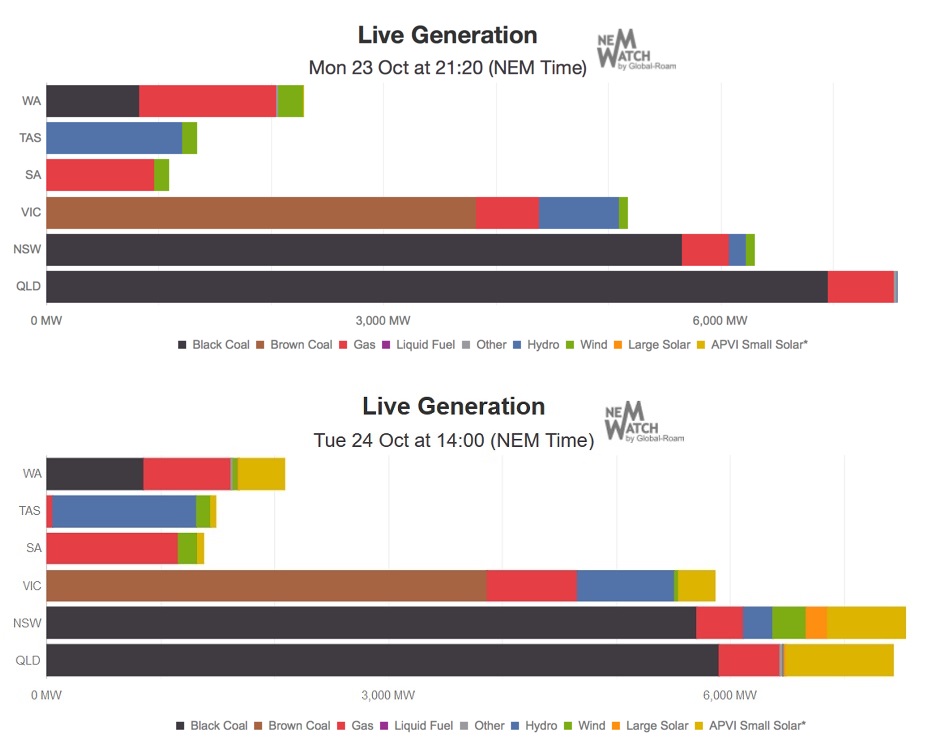
Australia’s generation mix last night and today. Plenty of room for more renewables.
With some effort we could very quickly get to the point where we are producing enough surplus, clean, renewable electricity that energy storage is needed to reduce emissions. But I doubt that effort will come any time soon, because I really can’t see the Coalition suddenly saying, “Oh my god! Tony Abbott was actually wrong about something! Coal smoke doesn’t cure cancer, it causes it! Let’s shut down coal power as quickly as we can!”
We Should Subsidise Renewable Energy — Not Energy Storage
Energy storage won’t reduce emissions right now, but renewable energy will. Because we live in a world of scarcity, it would be foolish to spend money subsidising energy storage instead of renewables. While we could subsidise both, that would be stupid, because we would do more good if we spent all the money on building more renewable capacity.
If we reach a point where clean renewable energy is regularly going to waste and it is clear that subsidizing energy storage would reduce emissions by more than subsidizing renewables, then we can subsidise energy storage.
It’s not as if we need a lot of lead up time. After all, it only takes 100 days to build the world’s largest battery4.
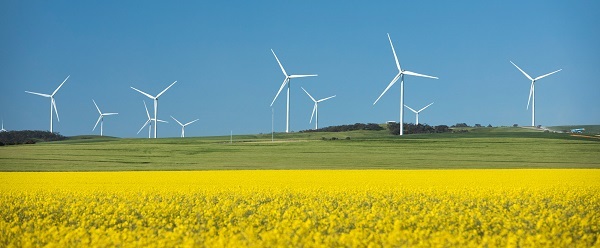
A very pretty picture of the Hornsdale Wind Farm where the world’s largest battery storage system is being built. (Don’t tell anyone, but it normally doesn’t look this good.) Image Credit: Hornsdale Wind Farm.
Energy Storage Without Subsidy Is No Problem
Just to be clear, I’m not saying that no energy storage will be built or that we should stop people from building or installing it. If someone decides they can make money by building storage and trading electricity it would be foolish to try to stop them. If a business decides that building renewables plus storage is cheaper than the grid, then they should go for it. I’m just saying it makes no sense to subsidise it right now.
Energy Storage Will Be Built Anyway
I am confident we will end up with lots of of energy storage without subsidy. Once solar batteries fall enough in price many more homes are likely to install them. Electric cars have large batteries that can slurp up surplus renewable energy. A thermal solar power plant with molten salt storage will be completed in South Australia in 2020 and may be the first of many. And utility scale energy storage on the grid can have many benefits in addition to electricity arbitrage5. These include providing ancillary services that help stabilize the grid and avoiding the need for new transmission lines.
By the time energy storage can provide an environmental benefit we may already have enough to provide that benefit.
Snowy 2 Is A Lifeline For Coal Power
Because the weather has yet to be privatized, wind and sunshine are free. This means once solar panels are installed on a roof or a wind turbine is erected, it costs nothing, or almost nothing, for them to supply electricity. So when their output is high and demand is low they can drive wholesale electricity prices down to zero6. This effect tends to drive coal power stations out of the market as they are generally too inflexible to shut down during periods of low prices and so are forced to operate at a loss.
But because large-scale energy storage will slurp up power when prices are low, it will raise the minimum wholesale price for grid electricity and so reduce, or possibly eliminate, the periods of time that coal is forced to operate at a loss. This may increase coal plants’ profitability and the length of time they continue to operate.
When stored energy is sold it will cut the average maximum wholesale price of electricity, which will reduce the profitability of coal. But a lower average maximum price will decrease gas generation and at the moment this lost generation would be replaced with more coal power. Finally, until we greatly increase our renewable generating capacity, the losses that result form using storage will be made up by the next cheapest source of electricity, which is coal.
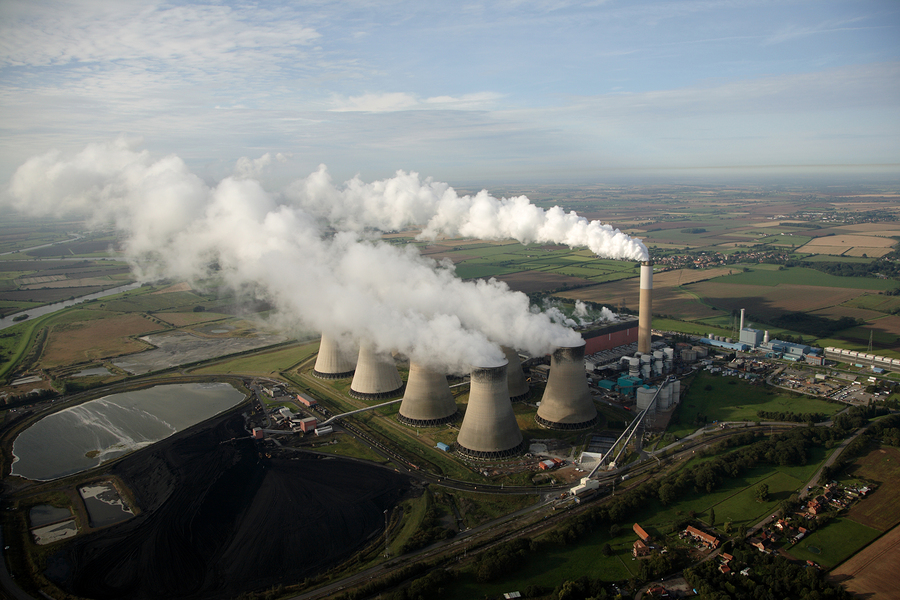
This coal power station would prefer it if you spent money on energy storage rather than rooftop solar.
This Country Deserves To Be Run By Smarter Idiots
Australia now has strong support across the political spectrum for subsidising energy storage. The Coalition and their pals in the Murdoch press have successfully spread the lie that we’ve hit some kind of threshold, and building more renewables will destroy grid reliability. So it makes good politics to propose subsidising storage instead of renewable generation, conveniently forgetting that storage consumes energy instead of generating it.
Unfortunately diverting subsidies from renewables to energy storage will harm the environment consuming money that could have been spent protecting it.
It seems as if no one bothered to check first to see if their plan would work in reality. That is pretty bloody slack, even if you give the Coalition a free pass by assuming they never had any intention of protecting the environment in the first place.
There is a lot of hype out there about energy storage and subsidising storage certainly seems to be a vote-winner. But if you’re a politician, before you go around promising to spend one hundred million to billions of dollars on energy storage, it’s really important to check that the hype you’ve bought into is correct and your plan will do what it’s meant to and not the opposite.
I don’t actually know if there is an objective reality out there. All I know is my life is a lot easier if I pretend there is one. And I think our lives and the health of our planet would be better if our leaders checked their plans against reality every now and then.
Footnotes
- If the subsidy is just for power output and not energy, I have a large capacitor I’d like to enter into the scheme. ↩
- 77% if you don’t include the contribution of rooftop solar. ↩
- And the curtailment of wind in SA right now is not a engineering necessity – it is a political necessity because Jay Weatherill can’t risk any load shedding before the election next year. Our energy politics is so toxic that any hiccups in SA’s world beating, 50% renewable grid is used as a big stick to beat renewables with. In a saner world SA would be supported when things go wrong with the understanding that any massive, pioneering engineering project will have many setbacks. ↩
- Actually, Elon got a bit of a head start on that battery and it looks almost complete now, well before the 100 day limit, so unfortunately it looks like we are not going to get it for free as a result of Tesla being slack. About our only hope now of getting a free battery is if enough American engineers get killed by dropbears. Unfortunately, the trees at the location aren’t very tall, so the dropbears don’t have very far to fall and so can only kill short people. We can only hope they learn to climb the local wind turbines and start flinging themselves long distances by sliding down the rotor blades. ↩
- Arbitrage is buying low and selling high. If this results in you getting a cannabis conviction, your are doing it wrong. ↩
- Because of the way our Renewable Energy Target works, it is possible for solar and wind farms to drive prices below zero, but I’m not going into that now. ↩

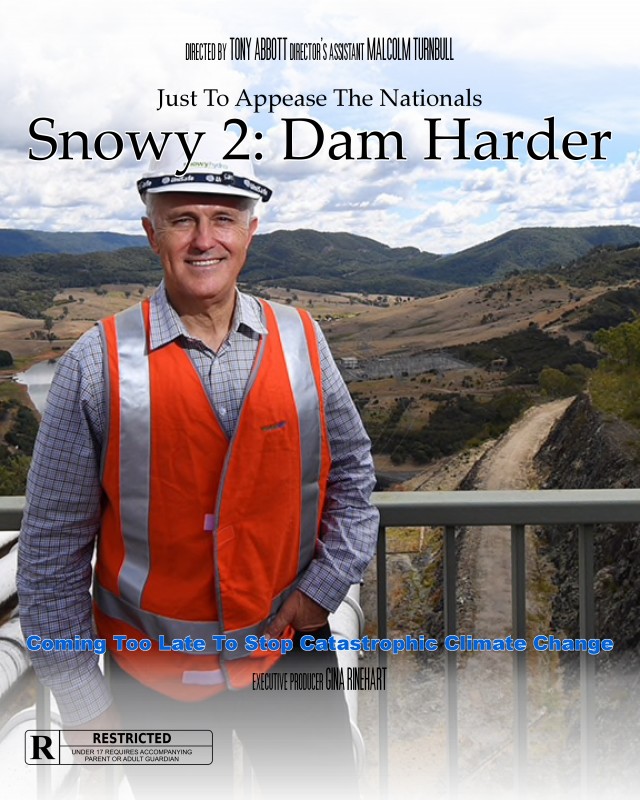
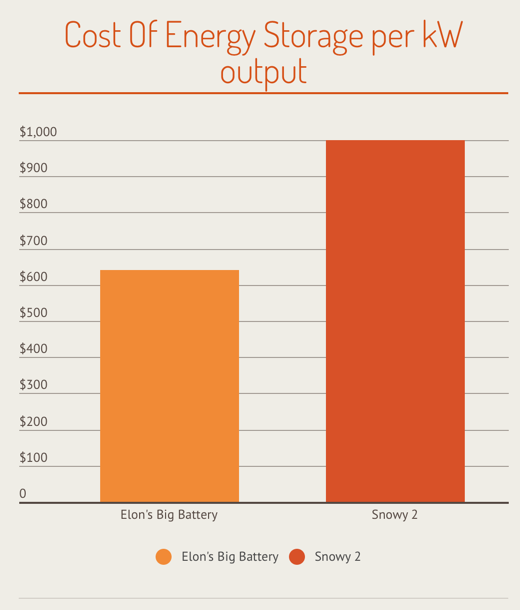
 RSS - Posts
RSS - Posts



The battery storage is supposed to be tagged onto renewable sources to save burning coal when there isn’t enough sun or wind. The whole point is to replace coal with a workable and reliable renewable energy grid. It will need batteries. And without batteries, renewables aren’t reliable enough.
I don’t know what’s so difficult to understand about that.
The difficulty is that we are saddled with hopelessly biased complete fuckwits in Canberra, most if not all of whom are in the pocket of the coal industry. Take for example that mindless lunatic Senator Roberts who believes global warming is a communist plot to take over the western economies. Surely its time for imbeciles like this to be consigned to the funnyfarm !!!!.
Exactly. We can build all the solar we want but at night we’d run off coal and this would forever be the anti renewables war cry… Ha ha idiots what do you use at night then? Coal? Well renewables obviously suck
If we build lots of storage this argument is gone and so is coal because with dropping battery prices and already cheap super it’s obvious coal can’t compete.
While I agree with much of your argument, it’s hard to understand your objection to subsidised storage, Ron.
As I’ve stated in the past, we have no panels or battery storage ourselves, but most of our rentals have solar electricity systems (and many have solar HWS, as well as other useful initiatives, like high-quality solar reflective film on sun-facing windows.) All these tenants are currently benefitting from high tariff rebates right now… but most of these ten-year contracts’ rebates will drop by 85% within 18 – 24 months.
We’d seriously consider installing battery systems to assist these tenants, if subsidies made this more affordable. We’d also consider initiating panels and battery storage at our own property. If not, we’ll continue to wait… and actively work for a change of government… .
My objection is simply that at this time energy storage doesn’t reduce emissions and so we and our grandchildren would be better off if we instead spend the money subsidizing what does reduce emissions, which is renewable energy.
I understand your previous argument but aren’t we now in situation that to ensure a stable grid we need more storage along with renewables to ensure an orderly progression otherwise they will just build out with gas.
South Australia is in a precarious situation which storage can only help. Post-blackout, the AEMO in its wisdom has insisted that unless four large gas generators are online within SA, wind’s contributions must be curtailed at 1200MW. That’s a lot of wind power being dropped on the floor. Not only might storage persuade the regulator to relax that condition, it can also soak up any wind power that needs to be curtailed (for regulatory reasons or just because demand is fully met and transmission is maxed out).
http://reneweconomy.com.au/wind-output-constrained-in-south-australia-as-it-blows-above-1200mw-20078/
Comparing Snowy 2 vs. SA’s big battery in terms of dollars per KW power capacity without mentioning dollars per unit energy stored is a bit silly. The capacity of those dams is enormous — many hours of generation, not just 70 minutes.
Moreover, while it’s true Australia “has a coal problem”, we only have 20 coal-fired power stations left, we haven’t built a new one in a decade, we’ve been closing the old ones at a rate of one per year, and (if we keep on building additional renewable generation capacity, which we *must*), we’re likely to start closing them faster than we have been. Our generation system will increasingly be dominated by renewables and flexible gas. Storage will predominantly displace gas.
Jonathan, South Australia isn’t in a precarious position. It’s position is fine. The AEMO has said as much. In fact, thanks to panicky SA politicians shelling out for batteries and extra gas generators, and with the El Nino indicator at neutral, there is below average risk of blackouts this summer.
Excellent news, that the SA grid can be relied on! The rest of my comment stands.
Just to be clear, the chance of load shedding is lower than usual, but doesn’t mean there won’t be any. Anyone who has grown up in any part of Australia knows that blackouts have long been a feature of Australian grids.
AEMO’s requirement for synchronous generation isn’t political, it’s for system strength, ie fault current. If a transmission line touches the ground, you actually want the grid to push a massive current through it, because your big circuit breakers will switch off as they’ll recognise it’s a fault. Current wind turbines don’t provide this system strength.
At the moment the only option to provide this service in SA is the gas generators. In future it can be provided by Concentrating Solar Thermal or, pumped hydro energy storage. With a bit of planning, Northern Power Station’s turbines could have been re-purposed as synchronous condensers, which also would have provided this service.
https://www.aemo.com.au/-/media/Files/Electricity/NEM/Market_Notices_and_Events/Power_System_Incident_Reports/2016/Power-System-Operations-Incident-Report_SA13Nov16.pdf
That’s very interesting. Thanks for the link.
AEMO also cite the *distance* to synchronous sources being a factor in this class of ‘local’ fault detection. Not sure what the implications of that are for storage placement, but the reason the wind turbines shut down was an issue at the other extreme, with not enough power in the local grid to keep them ‘awake’.
In the absence of adequate ‘local’ synchronous power, the cascade effect is widespread, sudden and dramatic.
AEMO’s agenda is security and scalability, with a weather eye to cost, but you’d think some work on how/why this plant steps down from the grid this way is warranted(?) – while we buy time with some local gas.
Australia has the largest integrated grid architecture in the world. We really should be solving these problems with a view beyond importing other people’s ‘local’ solutions. We own mining engineering, why not this too?
Also, why does the Green look like Labor’s Penny Wong, and the Lib look like the Greens’ Richard di Natale? 😀
Ron….. me thinks you have a blind spot?
If every PV site in Australia that is exporting KWH (and receiving a pittance in return) installed storage – and then consumed their own stored energy – would not the grid have a much smoother load profile – allowing a much smaller base load commitment from coal? Resulting in lower emitions.?
Smooth load profiles actually suit relatively inflexible coal very well. The point made in the main article is that storage involves losses (you never get as much energy from a battery as you spent charging it), but time-shifting to smooth demand equally favours old-school “baseload”, whereas spiky demand curves tend to encourage the use of more flexible (and lower-emissions) gas-fired generation instead.
At this point in time, if every PV site in Australia that is exporting kWh installed storage and then consumed their own stored energy – the grid would have a smoother load profile and emissions would increase. This is because energy would be lost using the storage since storage is never 100% efficient and, at this time, the losses would be made up by with fossil fuel generation. So it is much better to spend money subsidizing renewable generation capacity than energy storage.
Energy is measured in kJ or kWh. Not kW.
Heck, we even know the size of the Tesla battery – 129 MWh or 464.4 gigajoules.
Maybe if we could be told the cost of storing each gigajoule of electricity in Snowy Hydro 2.0 vs a 464.4 gigajoule Tesla battery, we would be able to reach a fair conclusion.
Hi Jacob,
No-one said energy was measured in kW. That would be silly.
The power output of a battery is important too. Generally power is more valuable than energy for grid support.
Besides no-one seems to know what the energy capacity of Snowy 2 will be.
Finn
An explanation of the difference between kilowatt and kilowatt-hour:
https://www.solarquotes.com.au/blog/kw-and-kwh-what-is-the-difference/
HI Ron,
While I am very keen to reduce greenhouse gas emissions, I don’t understand your post.
Storage to ameliorate intermittency seems necessary for night time, wind variations, (regular eg stronger afternoon wind and generally weaker morning wind) a string of wet days and maybe to smooth peaks (although this amounts to some extent to a subsidy to those who have outrageously high intermittent energy usage).The alternative is gas which has emissions including all the fugitive emissions, or giving coal fired power stations a guaranteed minimum daily output guarantee a couple of days in advance on a take or pay basis to keep them operating to fill supply shortfalls.
The design would need to take into account very detailed usage patterns, have a margin of safety to prevent blackouts.
Bigger and more Interconnectors may also help fill supply shortfalls from renewables.
At some stage storage is needed to guarantee supply as teh amount of excess capacity and interconnectors needed would be a less than optimal economic solution. Whether we are there yet of not I don;t know as there seems to be know readily available modelling.
CSIRO have modelled it. By their analysis renewable penetration up to 30% is “trivial” with the existing grid mix. In 2016 we generated 17.3% of Australia’s energy with renewables. Remove hydro from that and we are at 10% renewables.
Still a long way to go before we need storage to help integrate it.
And by the time we are up to 30-40%, there will be plenty of storage built without subsidy.
Thanks Finn
1 can anyone provide a link to the modelling Finn referred to?
2. Taking into account the limitations on interconnectors and the 30% constraint are there state networks where there is room to vastly increase renewables without hitting other huge constraints such as grid capacity to move the electricity to where it is needed. IE where is the most cost efficient place to place new solar or wind in big dollops?
Ron,
I hate to say this but a lot of your article shows a lack of knowledge of physics. Can you realise that the common unit of electrical energy is kWhr not kW. You store kWhr or MWhr or GWhr. If your device stores 500MWhr (from memory the storage capacity of Split yard Ck pumped hydro just down the road from me) then it it should be able to supply 50MW for 10 hours (x efficiency factor, claimed around 85%). You are correct that overall they are not very efficient (claimed 75% but probably lower) when pumping losses are included and so use more coal but are very useful for peak loads and for grid stabilization. Large batteries such that SA will have will smooth out variable input from renewable sources but do not have the capacity (GWhrs) to back up renewable sources for any reasonable time and neither will molten salt. We all love renewable sources but hate extended blackouts which is what your suggestion could produce. In 8 words ‘cheap, continously, clean you can have any two’.
Kilowatt is a unit of power and that is what I am specifically referring to when I use it in the article and not energy. The first time I used it I linked the word to a definition of its meaning.
The maximum amount of power Split Yard Creek pumped hydro can supply at any one time is 500 megawatts. When full it can do this for up to 10 hours, so it can supply a total of 5,000 megawatt-hours of energy before it runs dry.
Snowy 2 will, so we’ve been told, will supply 2 gigawatts of power. Because the upper reservoir will be huge it will be able to store a huge amount of energy when full. Apparently will be able to supply over 2,000 gigwatt-hours of electrical energy before it runs dry.
The SA battery will be able to provide 100 megawatts of power and provide 139 megawatt-hours of electrical energy, so if it was discharged 100% it could supply 100 megawatts for 1 hour and 23 minutes.
Hi Bob,
I can’t find one instance in the post where energy and power are mixed up, or the wrong units used.
If you have a specific example, please point it out.
Finn
I think Ron has used the terms correctly, although I think I do see the point that some of the commenters are making.
A storage facility (battery, pumped hydro or whatever) needs to be characterized by at least two parameters, both of which are important in different ways:
a) Amount of energy that can be stored (in kWh, kJ, MWh, MJ, GWh or GJ)
b) Power which can be produced from the stored energy – in other words, rate at which the energy can be retrieved- in kW, MW or GW)
That grey and orange chart is labelled correctly as far as I can see, but I think the confusion arises because the comparison is on the amount of power released rather than the amount of energy stored – confusing because “Storage” appears in the title, perhaps?
I think we do know both parameters for the Tesla battery but don’t know both for Snowy 2 – correct?
To be fair on the states’ policy makers, the decision to invest in storage was triggered by the insight (intermittent) renewables require grid scale storage to address base load requirements/real world grid architecture.
The fact you can see this in the bottom of a beer glass doesn’t reflect well on our nation’s vision for this stuff, but at least it’s now a Thing.
As several people have pointed out, Snowy II is a lot cheaper than any battery in terms of ongoing energy cost, and you can forgive some relative inefficiency given its sensational usable life. Decades VS years.
These are big steps towards removing one of the key arguments against renewables’ validity as the backbone of our national grid. ANU’s analysis supports the combined cost of renewables and pumped hydro, along with commensurate additions to the grid *already* being cheaper than coal/gas.
This means there’s no need for any subsidies, or carbon pricing. There’s more money in renewables already!
To your point, buying batteries for grid scale capacity is insane, but it’s an expedient remedy with good optics. Subsidising domestic batteries is just whataboutery, and wastes capacity that should be shared over far more efficient wire-the-size-of-your-thumb out the front. All true.
Unfortunately, we can’t applaud the meta (storage is necessary for grid scale renewables) and then pick and choose how it’s implemented. Dumb is just another type of transmission loss in any big design. Gotta learn to live with it.
C’mon Ron, I’m a little disappointed in you for not thinking a bit further ahead.
Solar is on a massive roll now and we’ll see heaps of it installed each year for many years, decades even. The only reason it’s not happening faster (large scale at least) is because the transmission and distribution networks can’t connect them up fast enough. Powerlink in Qld has 18 months solid work on the books.
So solar is coming unabated. It is cheap enough now to continue with little or no subsidies too. The subsidies for solar have served it’s purpose and brought costs down in a big way.
Now it’s time for the same to occur with storage.
Whilst your argument may be true that storage will initially help coal and delay it’s demise, coal will still be forced out of the market.
Most storage will be installed by solar proponents for the purpose of avoiding curtailment like we’re seeing happen in SA occasionally. By having storage in place it can be used to prevent having to run synchronous generation to provide ‘grid stability’. Batteries will be able to do that better in the long run.
Given that the storage market will be absolutely huge, maybe subsidies could also go towards manufacturing batteries in Australia? Prevent some money going offshore at least.
“Now it’s time for the same to occur with storage.”
I agree. According to the ANU we’re going to need 500 GWh of energy storage to reach 100% renewables. We should start investing now, building demonstration sites using different storage technologies and proving that wind, solar and energy storage can pick up the slack as coal generation closes.
Good article although I suggest that starting with such a provocative title is provoking more than pure thought.
I don’t think you are suggesting that storage is an intrinsically bad thing, but that in a budgetary choice between investing in two alternatives, my dollars are better spent on renewable sources rather than storage. For today at least.
I’m in two minds about this. If we consider only today (and maybe the next few years) I think you are correct. However I expect this will become less true over time, and likely for the best possible reasons… renewable generation capacity has rapidly evolved from limping along with the help of subsidies to soaring by itself, to the point where coal is rapidly becoming a bad investment. Maybe it would have got to this point without subsidies eventually, but I think the proliferation of panels on rooftops has done something to stimulate and inspire the domestic market in particular.
So, to the future – storage likely needs to go through that same learning curve (for want of a better term), develop economies of scale etc. and this probably won’t happen without a bit of help.
It’s certainly a hot topic at the moment and much of what the article says is valid.
Unfortunately, the argument about subsidising Renewable generation or Storage deflects attention from the more important focus of removing subsidies from fossil fuel generation.
Geez!…I’m glad I’m not an expert!
Otherwise I might suggest letting the Great Southern Ocean use Port Phillip Bay ( among umpteen other such natural reservoirs along our 150,000km coastline) as water storage dams. ( Particularly with some mechanical adjustments put in place.)
Port Phillip Bay….er, ‘currently’ only has an average tidal rise/fall of about half a meter due to narrow entrances, but it DOES have an area of 2000 sq.km., with water flowing almost 24/7 through those narrow tidal streams at around 20km ph.
The possibilities are endless ~ and any production requirements could be easily managed by opening/closing stop-cocks.
Not that expensive, either. Wouldn’t cost near as much (or generate as much heat) as the kerfuffle about Same Sex Marriage……whereas PUMPING water upstream could be seen as just another way of pushing shit uphill.
Question 1: regrading the “Chunks of flammable fossilized forest supplied 74%2 of electricity use in the 2016/17 financial year”, does that apply to the whole of Australia (including WA), or, does it apply only to the eastern states NEM thing, and, if it does not include WA, what is the proportion, for the whole of Australia?
Question 2: Whilst the article makes the point that battery storage associated with domestic rooftop photovoltaic systems, is not good for the environment, in a scenario like here, in the Perth metropolitan area (or, at least, in this neglected suburb of Perth) on the WA SWIS grid, with its unstable, unreliable, unsafe and erratic electricity supply (thankfully, the whitegoods manufacturers, more likely by accident than good design, appear to have made appliances more resilient, over the years, so, it is a few years since we have had an appliance destroyed or disabled by the bodgy grid electricity supply), where we are not (in the absence of a backup battery storage UPS system) allowed to use our domestic rooftop photovoltaic system in each event of an electricity “outage”, do you not think it would be worthwhile for backup battery storage systems in conjunction with domestic rooftop photovoltaic systems, where they can be used as UPS’s, and whence we would consequently be allowed to use our domestic rooftop photovoltaic system in each event of an electricity “outage”, to be subsidised and financed (by the government(as) and or utility companies, through interest-free loans, so as to facilitate electricity supply security and stability?
It would be good, to have a safe, stable, reliable, electricity supply.
1. That would be for the NEM last financial year. It will be a little lower this year thanks to expanding renewable capacity. I probably should have made that clear. The addition of WA and the NT would slightly lower the portion electricity supplied by coal.
2. However it is done, I think household battery systems should be fully compensated for the value of the electricity they supply and the grid stabilization services they provide.
“….conveniently forgetting that storage consumes energy instead of generating it.”
I don’t think they FORGOT it – they KNOW it consumes COAL GENERATED energy thus keeping coal power economically viable in a ‘free’ market.